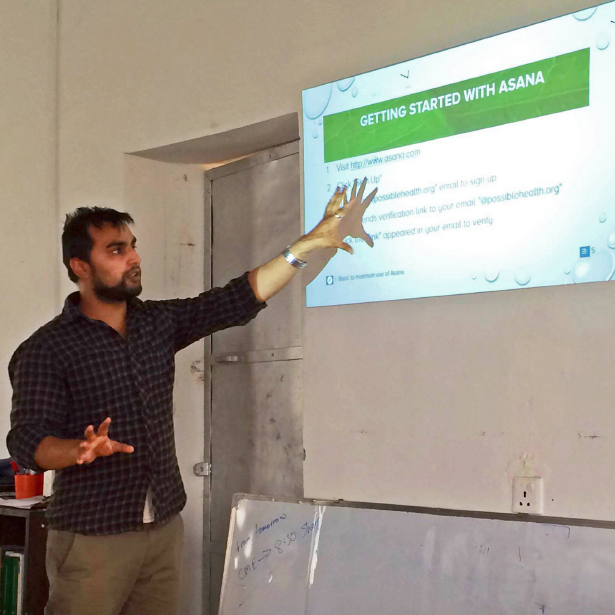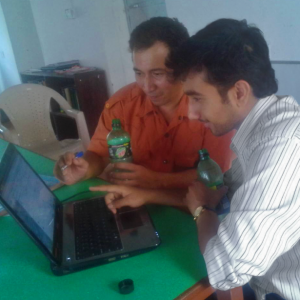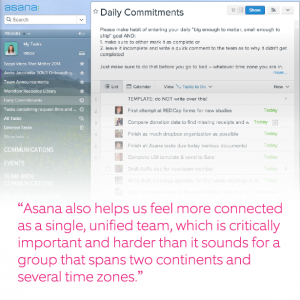Project Management Where It Matters Most
July 1, 2014 -
What place does Asana, an online project management tool used by many tech companies and entrepreneurs throughout the developed world, have in rural Nepal?
A really important one, actually.
Asana, a web and mobile app that supports team collaboration and communication through workspaces, projects, and commenting tools, is a product of Silicon Valley’s innovation boom. The company was founded by Facebook co-founder Dustin Moskovitz and ex-engineer Justin Rosenstein, and is popular among many in the Valley and other entrepreneurial offices.
With Asana’s mission being to “enable teamwork without email,” you certainly wouldn’t expect its presence in rural Nepal, where most people don’t even have an email address. Yet many of our 250+ Possible team members use Asana, including our senior leaders (doctors and nurses, program directors and officers) in Nepal. We’re big believers in creating impact through the use of effective tools that fuel efficiency and transparency, and Asana’s ability to create structure and accountability has been key to getting our remarkable work accomplished at an impressive rate. (We also use Dropbox, BambooHR, and Small Improvements.)
Promoting Asana usage in rural Nepal is no easy feat, and some challenges are easier to tackle than others. Yet these obstacles have not deterred our team from mastering workflows, and through the dedication and persistence of our Nepali leadership we have been able to onboard nearly everyone with a basic level of computer literacy.
As co-founder Rosenstein says, “Asana’s mission is to help humanity thrive by enabling all teams to work together more effortlessly. Our raison d’etre is building tools that enable others to benefit mankind, so it’s incredibly gratifying for us to see Asana helping Possible succeed in its mission.”
How Does It Work?
Amrit, our Community Health Program Officer, runs many of our Asana trainings in Nepal. After teaching himself how to use the app (Asana provides great online videos), he began setting up a series of training sessions where he walks through the basics: why we use the product in the first place, as well as how to make most of the functions and tools like creating projects and assigning tasks and deadlines. After each class, he makes himself available for one-on-one guidance, which people often take advantage of often.
“People pop into my office regularly!,” Amrit told me. “One of our physicians actually just came to my office so I could show him how to upload a photo.”
People are eager to learn Asana, too. In a recent staff meeting, Amrit announced he was doing another training session the next day, and everybody showed up. And that’s incredible, because not everyone has a computer background in Nepal; for many team members, Amrit’s Asana sessions would actually be their first time using a computer.
Two Continents, One Team
Asana’s use in Nepal doesn’t come without it’s fair set of challenges. In addition to an unreliable and often slow Internet connection, many team members don’t have access to their own computer. Amrit explained to me: “To turn our whole team into super users, we need to have computers for everybody so they can practice using Asana every day.”
One day we hope to get there. Until then, we can still celebrate how Asana has changed our overall operations in Nepal and the impact it’s had on our team and our patients. Team members are better able to organize their workload, prioritize their to-do’s, and be more accountable to their managers and colleagues. And when it comes to delivering high-quality healthcare to the world’s poor, staying on top of our workload is not only important—it’s vital.
Asana also helps us feel more connected as a single, unified team, which is critically important and harder than it sounds for a group that spans two continents and several time zones. We have a section for team-wide announcements where anyone can update the team on anything, from bringing on a new team member, to sharing internal documents and announcing noteworthy news. Each user also records their ‘daily commitment’ each morning; this is visible to everyone so we all know what others are working on and are all holding each other accountable, no matter where in the world we are.
I also asked Amrit what his favorite Asana feature was:
“Definitely the heart button,” he said, which is similar to a “Like” on Facebook.
“Sometimes, actions speak louder than words.”
Do Great Things
When chatting with many of our Nepali teammates in rural Nepal, I learned that before the days of Asana, many tasks were missing their deadlines, people felt less accountable towards their work, and Nepali team members weren’t always aware of what was happening in New York, Boston, or Kathmandu.
We have a ways to go in terms of some of the basics. Reliable Internet and electricity are not to be taken for granted in rural Nepal. But armed with tools like Asana and the determination to master them like Amrit, we’re able to Do Great Things even greater. We’ve treated over 173,000 patients since 2008 and more than doubled the investment of the Nepali government in our work in the last year.
“It’s been amazing to watch the Possible team roll out Asana to their employees in rural Nepal with great success,” says Rosenstein. “We’re proud to empower their team to make their greatest contributions to the world, no matter where they are.”
Learn about the other management tools and techniques we use to deliver healthcare to some of the world’s most impossible places in our Role of Management document.



